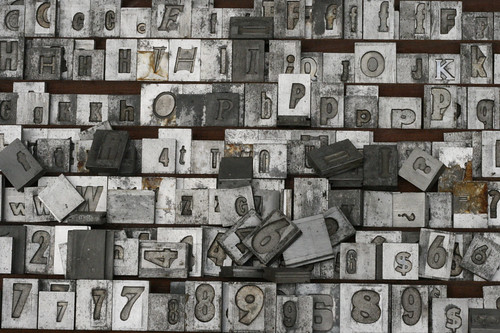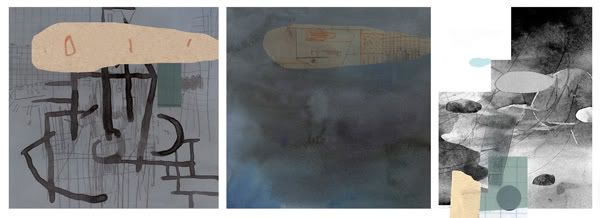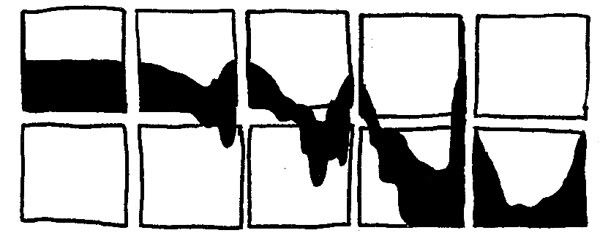quaqua sprrtzz popo
jkktvzdn prpp tsff
grd grdd grdddd dd
I'm betting that most of you just read those words in order, first line first, then the second, etc. Maybe you gave up long before that final "dd" (and wouldn't you agree it was such a magnificently subtle, understated chord on which to end?), realizing it was pure nonsense. Even so, you did begin, automatically, to scan those four lines as if they were regular text, intended to be read in a regular fashion, left to right then top to bottom.
On the other hand, if you just saw type specimens such as these:

you would immediately know that they are just disconnected letters, not intended to be scanned as reading, and you would be just content to look at the picture. Which is to say that, when looking at letters, knowing when to read or not to read, when to scan or not to scan, is all a matter of context and of learned habits.
Which leads me to abstract comics. Now, abstract comics, obviously, do not have a (verbal, summarizable) plot to push the narrative forward, one that would automatically prompt the reader to go to the next panel, and the next, and the next. They make up for it in a variety of ways. They can show shapes recurring and slowly changing from panel to panel, as in this excerpt from Warren Craghead:

They can rely on the continuity of an image across panels, while modulating the continuing shape to lead the eye downward and to the right, as in these two (?) tiers from Ibn al Rabin:

Or they can rely on the sheer energy of the compositional vectors in each panel to move the reader's eye sequentially (or at least to give it the feeling of sequential drive, even if we may not stop to examine one panel at a time), as in these three tiers from a piece by Benoit Joly:

(All excerpts, by the way, are taken from pieces in the anthology.)
The variety of ways in which abstract comics can create sequence and panel-to-panel scanning even in the absence of story and plot still needs to be cataloged, and is certainly much much wider than the three possibilities I have posted here. Each successful comic does this in some way. If it does not do so from panel to panel, it may do it from page to page, as happens in a couple of examples in the anthology. Yet, even in the absence of any such signifiers of movement or of sequence, I think that--as with the nonsense words above--the very fact of images presented in panels, in a comics context, will at least give us a first impulse toward sequentiality. On the other hand--and similarly to the type specimens above--in a non-comics context, such as a gallery wall or a piece of fabric, such an image, if it has no further forces to guide the viewer's eye, will most likely not invite a sequential reading, but simply appear as, say, a patchwork of rectangles. Context is all, or at least a lot. We are practiced readers of comics, after all. We know how these gizmos are supposed to work. And I would suggest that that is the very first of our tools, the foundation upon which we can begin to build any more satisfying abstract sequences.

This comment has been removed by the author.
ReplyDeletewow!
ReplyDeletemaybe the germination of "Understanding Abstract Comics", or better yet: "Not Understanding Abstract Comics, But Loving Them Anyway Because My Eyes Don't Lie"
= )
nice liddle write-up Andrei.
i first read
"Brddroompptt jkvazeentup
quaqua sprrtzz popo
jkktvzdn prpp tsff
grd grdd grdddd dd"
as a Kirbyian sound poem,
almost a plaintext version of
Gustave Morin's
toon tune
sound poetry does indeed have quite a long history, here's a short write-up:
s o u n d p o e t r y
& here's an oddly enjoyable performance:
Hugo Ball's "Karawane" performed by Marie Osmond
is there any such thing as nonsense?
Hugo Ball by Marie Osmond? I'll never be the same.
ReplyDeleteNice essay Andrei! context is indeed everything--
the question comes to mind-must the sequencing of images follow a pre-determined pattern in order to function as comics, or may there be a more random interplay among them that illicits meaning? I think of a Rauschenberg print for example--Were I to see it as a comics page I may very well try to read it in a specific sequence, but find that impulse overridden by the desire to move freely from image to image. The free interplay of images may culminate in meaning that is just as significant but perhaps more malleable.
I don't know what "asdrrgfiggeeep" means
ReplyDeletebut I do know that "eep opp ork ah ah" means "I love you"
http://www.youtube.com/watch?v=dQXvfSJ2XOM
(check out the abstract-comic-guitar-solo!)
Thanks, Troy! Actually, I must admit, I've been interested in sound poetry for a while too--I haven't done it in a while, but I used to perform a pretty mean "Ursonate." Maybe I can be convinced to perform it at SPX or MoCCA someday...
ReplyDeleteGeoff--that's a really interesting question that bears more investigating, but for now let me just say that I'd have a hard time seeing a Rauschenberg print as a comic; not only the context is different, but it does not have any of the signifiers that would lead me to read it sequentially, whether in a traditional reading direction or not.
On the other hand, we should keep in mind Jason Overby's comment, to JTM's post, about whether "sequence" is absolutely necessary for reading comics... I will try to address it in a future post. I really like his emphasis on the "plasticity" of the comics page.
Ooh, interesting post. The context does certainly matter, doesn't it? Most often I view abstract comics impressionistically at first, just looking at the page as a whole. After a few of these, then I look at them sequentially. However, if there is text, I read that, then take a visual pass, then later on, see it as a whole. Same with regular comics, too. Sometimes a comic is just looked at as a whole, so as to feel it, but avoid understanding it, because that can spur the imagination the most.
ReplyDelete